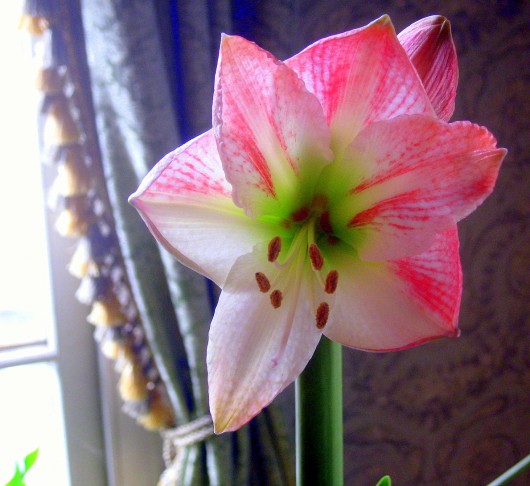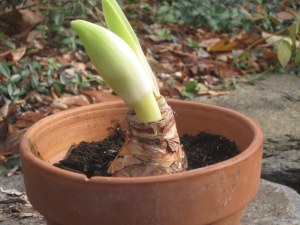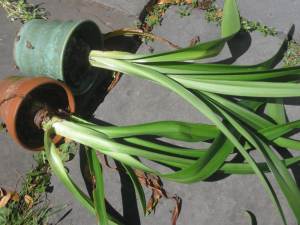Last updated on September 8th, 2020
 IN NOVEMBER, I usually succumb to the amaryllis (Hippeastrum) bulbs that florists offer. Who can resist these South African travelers with enormous, lily-like, winter-blooming flowers? The colors are sumptuous — pure white, apple-blossom pink, ruby red and crimson-orange, to name just four. The bulbs are great investments, too. They will stay with you for years if you give them proper care from the start:
IN NOVEMBER, I usually succumb to the amaryllis (Hippeastrum) bulbs that florists offer. Who can resist these South African travelers with enormous, lily-like, winter-blooming flowers? The colors are sumptuous — pure white, apple-blossom pink, ruby red and crimson-orange, to name just four. The bulbs are great investments, too. They will stay with you for years if you give them proper care from the start:
If unbudded at the time of purchase, the bulbs need at least six weeks for thorough root development, and then three or four additional weeks to perfect the flowers. If these do not appear, but only a disappointing amount of foliage develops, the amaryllis will claim one of three alibis — it was not sufficiently fertilized during the summer months; it was planted too deeply, or it was given such an oversize pot that all its energies have gone to filling the container with roots.
 Yearly flowering-success begins with a sturdy clay or glazed pot that is only one or two inches larger than the diameter of the bulb. A six-inch pot is usually right. Place a piece of broken pottery over the drainage hole, and then add a quantity of fresh, well-draining compost. Set the bulb high enough so that its top half rests above the surface of the soil, as in the photo up top.
Yearly flowering-success begins with a sturdy clay or glazed pot that is only one or two inches larger than the diameter of the bulb. A six-inch pot is usually right. Place a piece of broken pottery over the drainage hole, and then add a quantity of fresh, well-draining compost. Set the bulb high enough so that its top half rests above the surface of the soil, as in the photo up top.
Next, water well, and permit the bulb to make its roots in a dark, cool place (50-60 degrees). During the following six to eight weeks little watering will be required, certainly not more than once every 10 days.
After roots have sufficiently filled the pot the bulb will send up a flower bud. When this appears move the amaryllis to a sunny window. Water sparingly until the bud is 4 inches tall, then increase water as growth indicates a greater need for moisture.
Be sure to feed the plant, too. I feed mine with every watering, using a 1/4 teaspoon of high-phosphorous formula per gallon of water.
When blossoms fade, cut off the flowering stalks, but continue to care for the amaryllis just as you would your other houseplants. It is absolutely necessary to provide food and water freely through spring and summer, for this is when the bulb is producing its embryo flowers for next winter’s show. If possible, let the amaryllis spend the summer months outdoors in semi-shade.

Induce dormancy the first week in September. To do this, lay the pot on its side, as pictured above, and let the soil dry out. Remove the foliage after it turns yellow and becomes loose. Then bring the plant indoors to a dark, cool place. Give water not more than once every three weeks during the winter rest.
Check the plant occasionally from November on, although signs of growth are not likely until January. When the green point appears, scrape away the top soil and replace with a fresh mixture.
I hope you will treat yourself to at least one amaryllis this season. You’ll be happy to have the flash of color during the depths of winter.
Don’t miss anything at A Garden for the House…sign up for Kevin’s weekly newsletter.
Related Posts:
Tropical Bulbs in Pebbles, Water, and Gin
Forcing Hyacinths for Winter Bloom Indoors
Forced Bulbs: What to Keep, What to Toss

Justin says
Great advice. This explains why my amaryllis never bloom 2 years in a row. I didn't know you have to feed them during the summer. Your explanation makes perfect sense.
Phoebe says
I bought White Christmas amaryllis bulb from Lowes that came with a plastic pot (no drainage hole) and compressed soil. Should I use these things or go with a clay pot and miracle gro potting soil?
Kevin Lee Jacobs says
Phoebe – If you intend to keep your amaryllis for more than one season, definitely avoid the plastic pot which has no drainage hole. Plastic really isn't suitable for the long haul because it tips easily.
As for the compressed soil you mentioned, this is probably “Coir”(coconut fiber). It is excellent stuff. Soak it in warm water for a few minutes and you will see how easy it is to use.
Alan says
I bought 3 amaryllis this week: Christmas Story, Apple Blossom, and Susan. All the bulbs had a few little leaves coming out, but no flower bud yet. I'll follow your directions and hope for the best!
krystyna says
I have 8 Amaryllis plants and some from 2 years ago,they bloomed in deferent times,one did in July,some have 2 babies on the sides,should I take them apart from the ”mother ”.I love those flowers
Kevin Lee Jacobs says
Hi Krystyna – If the baby bulbs are about 1/3 the size of the mother bulb, go ahead and separate them. Rather than cutting the bulbs away, try to twist them off. Twisting will permit most of their roots to remain attached.
Betty says
I have kept a number of amaryllis for years and do almost none of these things. I get 2 bloom sessions a year-one in the fall/winter and one in the summer. My initial bulbs have produced a number of baby bulbs that have grown large and flowered. I fertilize occasionally not with every watering, do not rest my plants purposefully, although the bulbs take breaks on their own, and move them from a sunroom in the winter to outdoors in the spring, summer and early autumn. Just don’t over water them and they will reward you.
Anna says
I always sent the spent Christmas bulb to the garage for the winter and nursed for a small-but-still-charming bloom the next spring. This year I gathered the leftovers from several years and potted together for a nice foliage patio plant, complete with some fertilizer (first time I’ve been so generous as to feed them). I’m hoping for a repeat bloom this holiday season- thanks for the tips on coaxing them to dormancy first.
Kevin Lee Jacobs says
Betty – I suspect you have evergreen amaryllis, as opposed to the more common types described above. Evergreen types require no special care.
Anna – The fertilizing you gave your bulbs this summer will pay big dividends. The plants will bloom beautifully (if all other cultural conditions are met), although perhaps not in time for Christmas. Enjoy them!
Ardelle says
Several years ago I picked up 3 very nice bulbs in the clearance basket at a local garden center for $5 each – what a steal! These specific varieties currently sell for $28-$35. Since then they have developed babies which I BABIED each year and last season I had 7 beautiful plants that produced 2 – 3 stalks with 2-3 flowers each. I will follow your procedures during this next cycle to make it much less work. I had been taking them out of the pots and setting them into the garden directly, digging them in the fall, curing them and then replanting them – you eliminate a lot of work. Great fertilizing suggestions too. I love my favorite, Cherry Nymph which is a very full double. I just may have to spring for some of the newer varieties – love the white with red edges. Just a suggestion – the little bulbs are really easy to nurture to full flowering bulbs although it can take 2-3 years.
LynnB says
Here in Australia, we call them naked ladies. Do you?
Sue says
Hello Kevin.
Love your blog! I have been growing bulbs in pots for several years and stumbled across your site this winter while looking for some inspiration. I have found so many great ideas.
Can you recommend a brand of fertilizer for amaryllis. I invested in several huge bulbs that are blooming now and are over four feet tall. The leaves are just coming out and I have not fertized. I would like to get them to bloom again but am having difficulty finding the correct fertilizer.
Thanks
Snowy says
I know you posted this blog entry about 10 years ago, but meanwhile, just wondering: what high-P fertilizer are you using? Jack’s Blossom Booster (10-30-20), perhaps? I ask because the instructions on the canister say exactly what you do: 1/4 tsp per gallon when used as a constant feed program. (I prefer to use a constant feed program, because not every bulb grows at the same rate, so they don’t all require water at the same time. I only water when needed.)
This contrasts with the 1 tablespoon per gallon for outdoor plants (doesn’t say whether that means for in-ground or pots).
The reason I bring this up is that, if someone has to use some other type of high-phosphorus fertilizer, it might be helpful to know that, if you’re doing constant fertilizing, it’s possible the reduction from the outdoor rate is to divide by twelve. (1 tablespoon=3 tsp; and 1/4 tsp is a twelfth of 3 tsp.)
I wonder if, in the ten intervening years since you wrote this article, you’ve found that mixing the fertilizer every single time, when you have so many other things to do, has gotten to be a chore. Have you tried the slow-release fertilizers, such as Osmocote? Perhaps combined with enriching the soil with bone meal, when you plant?
Kevin Lee Jacobs says
Hi Snowy – I’ve tried all kinds of plant foods, including Osmocote and other dig-ins. For potted flowering plants, nothing beats Jack’s Classic Blossom Booster. I still use the stuff religiously!
Joe says
Kevin, I have an amaryllis that I bought after reading this entry some years ago. I followed your advice, and this thing has turned into a freak of nature. I kid you not when I say it blooms at least twice a year, in January and then again in June or July. It formed side-bulbs in the pot and they too often bloom. So, this week I picked up the pot and got ready to bring it indoors for its rest, per your instructions above. Guess what? Flower stalk coming up on one of the side-bulbs. I don’t overfertilize it so it must be darn happy in that pot but imagine the crowding of the roots! Should I remove the whole thing and give the side-bulbs pots of their own and repot the mother? I would appreciate your advice. Thanks!
Kevin Lee Jacobs says
Hi Joe – Holy cow — that’s one happy amaryllis you have there! My best advice is to induce dormancy now as usual. When new growth begins in winter/late winter, separate and pot up the baby bulbs, and repot the parent. May your amaryllis success continue!
Susan Stephens says
Hi Kevin,
Thank you for your blog and information. I inherited a cherry nymph amaryllis from a friend who had too many plants. I am new to this plant. It had several long leaves when I got it in late fall and now all the leaves are slowly yellowing. I might have missed the window of time to stow it away in the dark. It’s currently in a well lit area and getting water once weekly. It’s planted properly with the bulb above the soil. Do you have any advice for saving the plant and inducing bloom? Should I go ahead and dry to give it some dormancy time even thought it’s December?